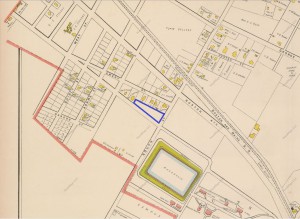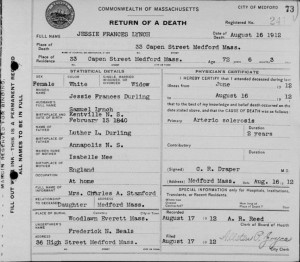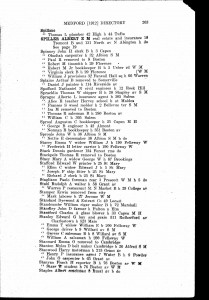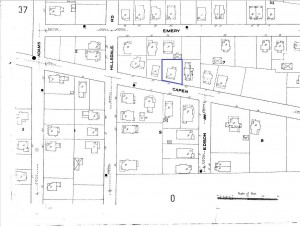
Recently, I moved from my hometown of Dedham to Medford, Massachusetts. I never really thought about it, but I had always assumed my family had no connections to places north of Boston. My mother and her siblings grew up in Needham (in Norfolk County), and my maternal grandfather and grandmother were raised in Dorchester and Roslindale, respectively.
When I moved, I haphazardly placed my copies of family records in a folder, which I planned to organize when I was settled into my new apartment. With extra time off during the holidays, I went through my papers, and made an interesting discovery.
One of my family mysteries is the ancestry of my great-grandmother, Mabel (Lynch) Muir. Her parents were John and Delia (Kerwin) Lynch. Delia was an Irish immigrant, and John Lynch arrived in Boston from Nova Scotia with his mother Jessie (Durling) Lynch and his sisters in 1867. John Lynch’s father, Samuel, died on 14 February 1892 in Boston, where John and Delia made their home.
 When cleaning out my records, I came across the death certificate of Jessie Lynch, recorded in 1912, which I hadn’t really looked at since I located it in 2013. Surprisingly, Jessie’s death, located in Massachusetts Vital Records, 1911-1915, revealed that she died at 33 Capen Street . . . in Medford, Massachusetts.
When cleaning out my records, I came across the death certificate of Jessie Lynch, recorded in 1912, which I hadn’t really looked at since I located it in 2013. Surprisingly, Jessie’s death, located in Massachusetts Vital Records, 1911-1915, revealed that she died at 33 Capen Street . . . in Medford, Massachusetts.
The location of Jessie’s death struck me immediately when I re-read the record; I currently live on North Street in Medford, and cross Capen Street everyday on my commute to NEHGS. What a coincidence that I unknowingly moved to the same neighborhood in which my great-great-great-grandmother resided prior to her death!
 I wondered how Jessie came to live in Medford. The informant on her death certificate was her daughter, Mrs. Charles A. Stamford of Medford. Emma Lynch, daughter of Samuel and Jessie Lynch, married Charles A. Staniford on 1 May 1878. In the 1912 Medford city directory, Charles A. Staniford, glassblower, was living at 33 Capen Street.
I wondered how Jessie came to live in Medford. The informant on her death certificate was her daughter, Mrs. Charles A. Stamford of Medford. Emma Lynch, daughter of Samuel and Jessie Lynch, married Charles A. Staniford on 1 May 1878. In the 1912 Medford city directory, Charles A. Staniford, glassblower, was living at 33 Capen Street.
Now that I knew how my great-great-great-grandmother came to live in Medford, I began to research the area, wanting to learn more about my new home. I was particularly interested in learning what the town looked like around the time that Jessie was living there, and how it had changed from the 1910s to the present.
The Medford Historical Society has several maps of the area digitized on their website. Though the society does not have any digitized maps from the 1910s, there are a variety of maps for the area ranging from the years 1637 to 1901.

In looking at the historical maps on the website, several aspects caught my attention. In 1855, the area where I live (and Jessie lived) was largely farmland, but by 1875 was more developed. By 1889, the lot for Jessie’s home on Capen Street appears to exist, but there is no indication of a house on the property, as indicated in other lots of land (highlighted above in blue). The Digital Sanborn Maps Collection gave me access to Medford maps created in 1910, where I located the Staniford household where Jessie once lived.
Looking at historical maps can be tricky. Changing street names and land development can make it difficult to pinpoint an ancestor’s home. Using a historic or well-known part of an area can help you locate an ancestor’s home on a map; I live close to Tufts University, and used the campus as a guide to locating the approximate area of my neighborhood. That proved especially helpful, as I learned that until about 1900 North Street had been known as West Street!
Hi, Katrina – I LOVE reading your discoveries! Especially this one. WHY? Because I, too, become excited when I discover something I had in common with an ancestor, yet no one in my family cares. They listen, and I think “They should be excited as I am, because they are as close to our ancestor as I am, but they don’t care… why?” I mean, they look at me with the same expression that Peyton Manning’s brother had on his face when Peyton won the Super Bowl! For example, even though I was never close to my father’s family because of all the “acrimony” after the “matrimony” ended (big divorce there), I want to find out more. I had an expanded major in theatre, but no one in my MOTHER’S family was ever involved, and I was considered “special” and “where did she get that in her gene pool?” Come to find out, my great grandmother MET her husband (yes, my g g grandfather) doing the “community theatre” at the turn of the century in Cedar City, Utah! No one knew…. (and my father and all his family are now deceased). SO…. it is a great discovery, and when I find someone who is excited about “coincidences” in their family tree, I, too, get excited! Especially since my family doesn’t seem to care. So you make me feel validated in my own discoveries, and I thank you! 😀
Well done post and THANKS! for the link. Have to pass it on to friend, but did I need that one. Resource links provided by VB posters are treasures. Bookmark them, people!
So, have you actually located and visited the 1910 33 Capen house yet or has number changes made it “invisible”?
Thanks for this article. I have a cousin who lives very close to where much of my family lived in the Minneapolis and Lake Minnetonka areas of Minnesota (from 1857 to 1920s). I’m not sure he had realized it before but said it was purely by happenstance that his work took him there. A few years ago we took him to see some of the family headstones at Lakewood Cemetery, the churches they had belonged to, Fort Snelling (where our grandfather enlisted for the Civil War) and tried to locate some of the addresses. It was – and still is – tricky because streets have changed. An irony for me is that I used to live in a town in New Hampshire – and never realized then all the roots I had there!
My great-grandfather built a house on Forest St. In Medford in 1906. My parents were living there with my great-grandmother when I was born. Though we only lived there until I was 2, Medford is still my hometown. And the house is still there.
I found my grandmother’s sister, Catherine Gray Lynch in the 1900 Census; she was a Professional Nurse at Massachusetts Charitable Eye & Ear Infirmary, 233 Charles St, Boston…… 2 blocks from my home. She later became a doctor who volunteered in France with her brother, Dr John J Lynch, during WWI
You supplied the link for the Sanborn atlases, but it requires a user name and password to actually gain entry. As members do we qualify for use of this important resource? If not, I’d suggest that we should!
I found this very interesting, especially because my grandfather died in 1954 at 28 Capen St. which appears to be next door. I remember visiting my grandparents there every Saturday when I was quite young.
I love these stories of serendipity. I grew up in Medford, so this was particularly interesting. Thank you for sharing.
The address of 33 Capen startled me.TNt grandparents and parents lived there prior to WWII and afterwards. (Grandfather was a professor at Tufts. I have photos . Ann Files